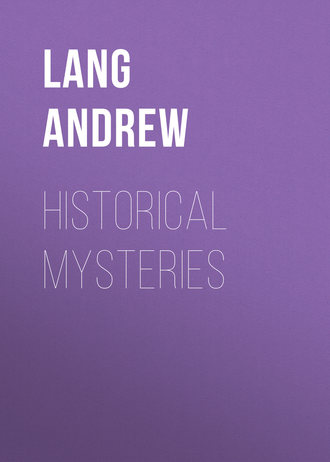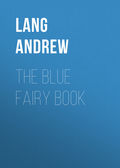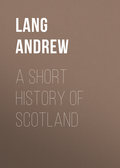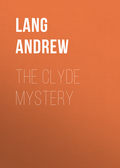
Lang Andrew
Historical Mysteries
I have not entered on the 'spiritual' part of the puzzle, the communications from 'spirits' of matters not consciously known to persons present, but found to be correct. That is too large a subject. Nor have I entered into the case of Mrs. Lyon's gift to Home, for the evidence only proved, as the judge held, that the gift was prompted, at least to some extent, by what Home declared to be spiritual rappings. But the only actual witness to the fact, Mrs. Lyon herself, was the reverse of a trustworthy witness, being a foolish capricious underbred woman. Hume's mystery, as far as the best of the drawing-room miracles are concerned, is solved by no theory or combination of theories, neither by the hypothesis of conjuring, nor of collective hallucination, nor of a blend of both. The cases of Sir David Brewster and of Dr. Carpenter prove how far some 'scientists' will go, rather than appear in an attitude of agnosticism, of not having a sound explanation.28
Note. – Since this paper was written, I have been obliged by several interesting communications from a person very intimate with Home. Nothing in these threw fresh light on the mystery of his career, still less tended to confirm any theory of dishonesty on his part. His legal adviser, a man of honour, saw no harm in his accepting Mrs. Lyon's proffered gift, though he tried, in vain, to prevent her from increasing her original present.
IX
THE CASE OF CAPTAIN GREEN
'Play on Captain Green's wuddie,'29 said the caddy on Leith Links; and his employer struck his ball in the direction of the Captain's gibbet on the sands. Mr. Duncan Forbes of Culloden sighed, and, taking off his hat, bowed in the direction of the unhappy mariner's monument.
One can imagine this little scene repeating itself many a time, long after Captain Thomas Green, his mate, John Madder or Mather, and another of his crew were taken to the sands at Leith on the second Wednesday in April 1705, being April 11, and there hanged within the floodmark upon a gibbet till they were dead. Mr. Forbes of Culloden, later President of the Court of Session, and, far more than the butcher Cumberland, the victor over the rising of 1745, believed in the innocence of Captain Green, wore mourning for him, attended the funeral at the risk of his own life, and, when the Porteous Riot was discussed in Parliament, rose in his place and attested his conviction that the captain was wrongfully done to death.
Green, like his namesake in the Popish Plot, was condemned for a crime of which he was probably innocent. Nay more, he died for a crime which was not proved to have been committed, though it really may have been committed by persons with whom Green had no connection, while Green may have been guilty of other misdeeds as bad as that for which he was hanged. Like the other Green, executed for the murder of Sir Edmund Berry Godfrey during the Popish Plot, the captain was the victim of a fit of madness in a nation, that nation being the Scottish. The cause of their fury was not religion – the fever of the Covenant had passed away – but commerce.
'Twere long to tell and sad to trace the origin of the Caledonian frenzy. In 1695 the Scottish Parliament had passed, with the royal assent, an Act granting a patent to a Scottish company dealing with Africa, the Indies, and, incidentally, with the globe at large. The Act committed the occupant of the Scottish throne, William of Orange, to backing the company if attacked by alien power. But it was unlucky that England was then an alien power, and that the Scots Act infringed the patent of the much older English East India Company. Englishmen dared not take shares, finally, in the venture of the Scots; and when the English Board of Trade found out, in 1697, the real purpose of the Scottish company – namely, to set up a factory in Darien and anticipate the advantages dreamed of by France in the case of M. de Lesseps's Panama Canal – 'a strange thing happened.' The celebrated philosopher, Mr. John Locke, and the other members of a committee of the English Board of Trade, advised the English Government to plagiarise the Scottish project, and seize the section of the Isthmus of Panama on which the Scots meant to settle. This was not done; but the Dutch Usurper, far from backing the Scots company, bade his colonies hold no sort of intercourse with them. The Scots were starved out of their settlement. The few who remained fled to New York and Jamaica, and there, perishing of hunger, were refused supplies by the English colonial governors. A second Scottish colony succumbed to a Spanish fleet and army, and the company, with a nominal capital of 400,000l. and with 220,000l. paid up, was bankrupt. Macaulay calculates the loss at about the same as a loss of forty millions would have been to the Scotland of his own day; let us say twenty-two millions.
We remember the excitement in France over the Panama failure. Scotland, in 1700, was even more furious, and that led to the hanging of Captain Green and his men. There were riots; the rioters were imprisoned in the Heart of Midlothian – the Tolbooth – the crowd released them; some of the crowd were feebly sentenced to the pillory, the public pelted them – with white roses; and had the Chevalier de St. George not been a child of twelve, he would have had a fair chance of recovering his throne. The trouble was tided over; William III. died in 1702. Queen Anne came to the Crown. But the bankrupt company was not dead. Its charter was still legal, and, with borrowed money, it sent out vessels to trade with the Indies. The company had a vessel, the 'Annandale,' which was seized in the Thames, at the instance of the East India Company, and condemned for a breach of that company's privileges.
This capture awakened the sleeping fury among my fiery countrymen (1704). An English ship, connected with either the English East India Company or the rival Million Company, put into Leith Road to repair. Here was a chance; for the charter of the Scots company authorised them 'to make reprisals and to seek and take reparation of damage done by sea and land.' On the strength of this clause, which was never meant to apply to Englishmen in Scottish waters, but to foreigners of all kinds on the Spanish Main, the Scottish Admiralty took no steps. But the company had a Celtic secretary, Mr. Roderick Mackenzie, and the English Parliament, in 1695, had summoned Mr. Mackenzie before them, and asked him many questions of an impertinent and disagreeable nature. This outrageous proceeding he resented, for he was no more an English than he was a Japanese subject. The situation of the 'Worcester' in Scottish waters gave Roderick his chance. His chief difficulty, as he informed his directors, was 'to get together a sufficient number of such genteel, pretty fellows as would, of their own free accord, on a sudden advertisement, be willing to accompany me on this adventure' (namely, the capture of the 'Worcester'), 'and whose dress and behaviour would not render them suspected of any uncommon design in going aboard.' A scheme more sudden and daring than the seizure, by a few gentlemen, of a well-armed English vessel had not been executed since the bold Buccleuch forced Carlisle Castle and carried away Kinmont Willie. The day was Saturday, and Mr. Mackenzie sauntered to the Cross in the High Street, and invited genteel and pretty fellows to dine with him in the country. They were given an inkling of what was going forward, and some dropped off, like the less resolute guests in Mr. Stevenson's adventure of the hansom cabs. When they reached Leith, Roderick found himself at the head of eleven persons, of whom 'most be as good gentlemen, and (I must own) much prettier fellows than I pretend to be.' They were of the same sort as Roy, Middleton, Haliburton, and Dunbar, who, fourteen years earlier, being prisoners on the Bass Rock, seized the castle, and, through three long years, held it for King James against the English navy.
The eleven chose Mr. Mackenzie as chief, and, having swords, pistols, 'and some with bayonets, too,' set out. Mackenzie, his servant, and three friends took a boat at Leith, with provision of wine, brandy, sugar, and lime juice; four more came, as a separate party, from Newhaven; the rest first visited an English man-of-war in the Firth, and then, in a convivial manner, boarded the 'Worcester.' The punch-bowls were produced, liquor was given to the sailors, while the officers of the 'Worcester' drank with the visitors in the cabin. Mackenzie was supposed to be a lord. All was festivity, 'a most compleat scene of a comedy, acted to the life,' when, as a Scottish song was being sung, each officer of the 'Worcester' found a pistol at his ear. The carpenter and some of the crew rushed at the loaded blunderbusses that hung in the cabin; but there were shining swords between them and the blunderbusses. By nine at night, on August 12, Mackenzie's followers were masters of the English ship, and the hatches, gunroom, chests, and cabinets were sealed with the official seal of the Scottish African and East India Company. In a day or two the vessel lay without rudder or sails, in Bruntisland Harbour, 'as secure as a thief in a mill.' Mackenzie landed eight of the ship's guns and placed them in an old fort commanding the harbour entry, manned them with gunners, and all this while an English man-of-war lay in the Firth!
For a peaceful secretary of a commercial company, with a scratch eleven picked up in the street on a Saturday afternoon, to capture a vessel with a crew of twenty-four, well accustomed to desperate deeds, was 'a sufficient camisado or onfall.' For three or four days and nights Mr. Mackenzie had scarcely an hour's sleep. By the end of August he had commenced an action in the High Court of Admiralty for condemning the 'Worcester' and her cargo, to compensate for the damages sustained by his company through the English seizure of their ship, the 'Annandale.' When Mackenzie sent in his report on September 4, he added that, from 'very odd expressions dropt now and then from some of the ship's crew,' he suspected that Captain Green, of the 'Worcester,' was 'guilty of some very unwarrantable practices.'
The Scottish Privy Council were now formally apprised of the affair, which they cautiously handed over to the Admiralty. The Scottish company had for about three years bewailed the absence of a ship of their own, the 'Speedy Return,' which had never returned at all. Her skipper was a Captain Drummond, who had been very active in the Darien expedition; her surgeon was Mr. Andrew Wilkie, brother of James Wilkie, tailor and burgess of Edinburgh. The pair were most probably descendants of the Wilkie, tailor in the Canongate, who was mixed up in the odd business of Mr. Robert Oliphant, in the Gowrie conspiracy of 1600. Friends of Captain Drummond, Surgeon Wilkie, and others who had disappeared in the 'Speedy Return,' began to wonder whether the crew of the 'Worcester,' in their wanderings, had ever come across news of the missing vessel. One George Haines, of the 'Worcester,' hearing of a Captain Gordon, who was the terror of French privateers, said: 'Our sloop was more terrible upon the coast of Malabar than ever Captain Gordon will be to the French.' Mackenzie asking Haines if he had ever heard of the 'Speedy Return,' the missing ship, Haines replied: 'You need not trouble your head about her, for I believe you won't see her in haste.' He thought that Captain Drummond had turned pirate.
Haines now fell in love with a girl at Bruntisland, aged nineteen, named Anne Seaton, and told her a number of things, which she promised to repeat to Mackenzie, but disappointed him, though she had blabbed to others. It came to be reported that Captain Green had pirated the 'Speedy Return,' and murdered Captain Drummond and his crew. The Privy Council, in January 1705, took the matter up. A seal, or forged copy of the seal, of the Scottish African and East India Company was found on board the 'Worcester,' and her captain and crew were judicially interrogated, after the manner of the French Juge d'Instruction.
On March 5, 1705, the Scottish Court of Admiralty began the trial of Green and his men. Charles May, surgeon of the 'Worcester,' and two negroes, Antonio Ferdinando, cook's mate, and Antonio Francisco, captain's man, were ready to give evidence against their comrades. They were accused of attacking, between February and May, 1703, off the coast of Malabar a vessel bearing a red flag, and having English or Scots aboard. They pursued her in their sloop, seized and killed the crew, and stole the goods.
Everyone in Scotland, except resolute Whigs, believed the vessel attacked to have been Captain Drummond's 'Speedy Return.' But there was nothing definite to prove the fact; there was no corpus delicti. In fact the case was parallel to that of the Campden mystery, in which three people were hanged for killing old Mr. Harrison, who later turned up in perfect health. In Green's, as in the Campden case, some of the accused confessed their guilt, and yet evidence later obtained tends to prove that Captain Drummond and his ship and crew were all quite safe at the date of the alleged piracy by Captain Green. None the less, it does appear that Captain Green had been pirating somebody, and perhaps he was 'none the waur o' a hanging,' though, as he had an English commission to act against pirates, it was argued that, if he had been fighting at all, it was against pirates that he had been making war. Now Haines's remark that Captain Drummond, as he heard, had turned pirate, looks very like a 'hedge' to be used in case the 'Worcester' was proved to have attacked the 'Speedy Return.'
There was a great deal of preliminary sparring between the advocates as to the propriety of the indictment. The jury of fifteen contained five local skippers. Most of the others were traders. One of them, William Blackwood, was of a family that had been very active in the Darien affair. Captain Green had no better chance with these men than James Stewart of the Glens in face of a jury of Campbells. The first witness, Ferdinando, the black sea cook, deponed that he saw Green's sloop take a ship under English colours, and that Green, his mate, Madder, and others, killed the crew of the captured vessel with hatchets. Ferdinando's coat was part of the spoil, and was said to be of Scottish cloth. Charles May, surgeon of the 'Worcester,' being on shore, heard firing at sea, and, later, dressed a wound, a gunshot he believed, on the arm of the black cook; dressed wounds, also, of two sailors, of the 'Worcester,' Mackay and Cuming – Scots obviously, by their names. He found the deck of the 'Worcester,' when he came on board, lumbered with goods and chests. He remarked on this, and Madder, the mate, cursed him, and bade him 'mind his plaister box.' He added that the 'Worcester,' before his eyes, while he stood on shore, was towing another vessel, which, he heard, was sold to a native dealer – Coge Commodo – who told the witness that the 'Worcester' 'had been fighting.' The 'Worcester' sprang a leak, and sailed for five weeks to a place where she was repaired, as if she were anxious to avoid inquiries.
Antonio Francisco, Captain Green's black servant, swore that, being chained and nailed to her forecastle, he heard the 'Worcester' fire six shots. Two days later a quantity of goods was brought on board (captured, it would seem, by the terrible sloop of the 'Worcester'), and Ferdinando then told this witness about the killing of the captured crew, and showed his own wounded arm. Francisco himself lay in chains for two months, and, of course, had a grudge against Captain Green. It was proved that the 'Worcester' had a cipher wherein to communicate with her owners, who used great secrecy; that her cargo consisted of arms, and was of such slight value as not to justify her voyage, unless her real business was piracy. The ship was of 200 tons, twenty guns, thirty-six men, and the value of the cargo was but 1,000l. Really, things do not look very well for the enterprise of Captain Green! There was also found a suspicious letter to one of the crew, Reynolds, from his sister-in-law, advising him to confess, and referring to a letter of his own in which he said that some of the crew 'had basely confessed.' The lady's letter and a copy of Reynolds's, admitted by him to be correct, were before the Court.
Again, James Wilkie, tailor, had tried at Bruntisland to 'pump' Haines about Captain Drummond; Haines swore profane, but later said that he heard Drummond had turned pirate, and that off the coast of Malabar they had manned their sloop, lest Drummond, whom they believed to be on that coast, should attack them. Other witnesses corroborated Wilkie, and had heard Haines say that it was a wonder the ground did not open and swallow them for the wickedness 'that had been committed during the last voyage on board of that old [I omit a nautical term of endearment] Bess.' Some one telling Haines that the mate's uncle had been 'burned in oil' for trying to burn Dutch ships at Amsterdam, 'the said George Haines did tell the deponent that if what Captain Madder [the mate] had done during his last voyage were known, he deserved as much as his uncle had met with.' Anne Seaton, the girl of Haines's heart, admitted that Haines had told her 'that he knew more of Captain Drummond than he would express at that time,' and she had heard his expressions of remorse. He had blabbed to many witnesses of a precious something hidden aboard the 'Worcester;' to Anne he said that he had now thrown it overboard. We shall see later what this object was. Anne was a reluctant witness. Glen, a goldsmith, had seen a seal of the Scots East India Company in the hands of Madder, the inference being that it was taken from the 'Speedy Return.'
Sir David Dalrymple, for the prosecution, made the most he could of the evidence. The black cook's coat, taken from the captured vessel, 'in my judgment appears to be Scots rugg.' He also thought it a point in favour of the cook's veracity that he was very ill, and forced to lie down in court; in fact, the cook died suddenly on the day when Captain Green was condemned, and the Scots had a high opinion of dying confessions. The white cook, who joined the 'Worcester' after the sea-fight, said that the black cook told him the whole story at that time. Why did the 'Worcester' sail for thirty-five days to repair her leak, which she might have done at Goa or Surat, instead of sailing some 700 leagues for the purpose? The jury found that there was 'one clear witness to robbery, piracy, and murder,' and accumulative corroboration.
The judges ordered fourteen hangings, to begin with those of Green, Madder, and three others on April 4. On March 16, at Edinburgh, Thomas Linsteed made an affidavit that the 'Worcester' left him on shore, on business, about January 1703; that fishing crews reported the fight of the sloop against a vessel unknown; they left before the fight ended; that the Dutch and Portuguese told him how the 'Worcester's' men had sold a prize, and thought but little of it, 'because it is what is ordinary on that coast,' and that the 'Worcester's' people told him to ask them no questions. On March 27 George Haines made a full confession of the murder of a captured crew, he being accessory thereto, at Sacrifice Rock, between Tellicherry and Calicut; and that he himself, after being seized by Mackenzie, threw his journal of the exciting events overboard. Now, in his previous blabbings before the trial, as we have seen, Haines had spoken several times about something on board the 'Worcester' which the Scots would be very glad to lay hands on, thereby indicating this journal of his; and he told Anne Seaton, as she deponed at the trial, that he had thrown the precious something overboard. In his confession of March 27 he explained what the mysterious something was. He also declared (March 28) that the victims of the piracy 'spoke the Scots language.' A sailor named Bruckley also made full confession. These men were reprieved, and doubtless expected to be; but Haines, all the while remorseful, I think, told the truth. The 'Worcester' had been guilty of piracy.
But had she pirated the Scottish ship, the 'Speedy Return,' Captain Drummond? As to that point, on April 5, in England, two of the crew of the 'Worcester,' who must somehow have escaped from Mackenzie's raid, made affidavit that the 'Worcester' fought no ship during her whole voyage. This would be more satisfactory if we knew more of the witnesses. On March 21, at Portsmouth, two other English mariners made affidavit that they had been of the crew of the 'Speedy Return;' that she was captured by pirates, while Captain Drummond and Surgeon Wilkie were on shore, at Maritan in Madagascar; and that these two witnesses 'went on board a Moca ship called the "Defiance,"' escaped from her at the Mauritius, and returned to England in the 'Raper' galley. Of the fate of Drummond and Wilkie, left ashore in Madagascar, they naturally knew nothing. If they spoke truth, Captain Green certainly did not seize the 'Speedy Return,' whatever dark and bloody deeds he may have done off the coast of Malabar.
In England, as Secretary Johnstone, son of the caitiff Covenanter, Waristoun, wrote to Baillie of Jerviswoode, the Whigs made party capital out of the proceedings against Green: they said it was a Jacobite plot. I conceive that few Scottish Whigs, to be sure, marched under Roderick Mackenzie.
In Scotland the Privy Council refused Queen Anne's demand that the execution of Green should be suspended till her pleasure was known, but they did grant a week's respite. On April 10 a mob, partly from the country, gathered in Edinburgh; the Privy Council, between the mob and the Queen, let matters take their course. On April 11 the mob raged round the meeting-place of the Privy Council, rooms under the Parliament House, and chevied the Chancellor into a narrow close, whence he was hardly rescued. However, learning that Green was to swing after all, the mob withdrew to Leith sands, where they enjoyed the execution of an Englishman. The whole affair hastened the Union of 1707, for it was a clear case of Union or war between the two nations.
As for Drummond, many years later, on the occasion of the Porteous riot, Forbes of Culloden declared in the House of Commons that a few months after Green was hanged letters came from Captain Drummond, of the 'Speedy Return,' 'and from the very ship for whose capture the unfortunate person suffered, informing their friends that they were all safe.' But the 'Speedy Return' was taken by pirates, two of her crew say, off Madagascar, and burned. What was the date of the letters from the 'Speedy Return' to which, long afterwards, Forbes, and he alone, referred? What was the date of the capture of the 'Speedy Return,' at Maritan, in Madagascar? Without the dates we are no wiser.
Now comes an incidental and subsidiary mystery. In 1729 was published Madagascar, or Robert Drury's Journal during Fifteen Years' Captivity on that Island, written by Himself, digested into order, and now published at the Request of his Friends. Drury says, as we shall see, that he, a lad of fifteen, was prisoner in Madagascar from about 1703 to 1718, and that there he met Captain Drummond, late of the 'Speedy Return.' If so, Green certainly did not kill Captain Drummond. But Drury's narrative seems to be about as authentic and historical as the so-called Souvenirs of Madame de Créquy. In the edition of 189030 of Drury's book, edited by Captain Pasfield Oliver, R.A., author of Madagascar, the Captain throws a lurid light on Drury and his volume. Captain Pasfield Oliver first candidly produces what he thinks the best evidence for the genuineness of Drury's story; namely a letter of the Rev. Mr. Hirst, on board H.M.S. 'Lenox,' off Madagascar, 1759. This gentleman praises Drury's book as the best and most authentic, for Drury says that he was wrecked in the 'Degrave,' East Indiaman, and his story 'exactly agrees, as far as it goes, with the journal kept by Mr. John Benbow,' second mate of the 'Degrave.' That journal of Benbow's was burned, in London, in 1714, but several of his friends remembered that it tallied with Drury's narrative. But, as Drury's narrative was certainly 'edited,' probably by Defoe, that master of fiction may easily have known and used Benbow's journal. Otherwise, if Benbow's journal contained the same references to Captain Drummond in Madagascar as Drury gives, then the question is settled: Drummond died in Madagascar after a stormy existence of some eleven years on that island. As to Drury, Captain Pasfield Oliver thinks that his editor, probably Defoe, or an imitator of Defoe, 'faked' the book, partly out of De Flacourt's Histoire de Madagascar (1661), and a French authority adds another old French source, Dapper's Description de l'Afrique. Drury was himself a pirate, his editor thinks: Defoe picked his brains, or an imitator of Defoe did so, and Defoe, or whoever was the editor, would know the story that Drummond really lost the 'Speedy Return' in Madagascar, and could introduce the Scottish adventurer into Drury's romance.
We can never be absolutely certain that Captain Drummond lost his ship, but lived on as a kind of condottiere to a native prince in Madagascar. Between us and complete satisfactory proof a great gulf has been made by fire and water, 'foes of old' as the Greek poet says, which conspired to destroy the journal kept by Haines and the journal kept by Benbow. The former would have told us what piratical adventures Captain Green achieved in the 'Worcester;' the latter, if it spoke of Captain Drummond in Madagascar, would have proved that the captain and the 'Speedy Return' were not among the 'Worcester's' victims. If we could be sure that Benbow's journal corroborated Drury's romance, we could not be sure that the editor of the romance did not borrow the facts from the journal of Benbow, and we do not know that this journal made mention of Captain Drummond, for the only valid testimony as to the captain's appearance in Madagascar is the affidavit of Israel Phippany and Peter Freeland, at Portsmouth, March 31, 1705, and these mariners may have perjured themselves to save the lives of English seamen condemned by the Scots.
Yet, as a patriotic Scot, I have reason for believing in the English affidavit at Portsmouth. The reason is simple, but sufficient. Captain Drummond, if attacked by Captain Green, was the man to defeat that officer, make prize of his ship, and hang at the yardarm the crew which was so easily mastered by Mr. Roderick Mackenzie and eleven pretty fellows. Hence I conclude that the 'Worcester' really had been pirating off the coast of Malabar, but that the ship taken by Captain Green in these waters was not the 'Speedy Return,' but another, unknown. If so, there was no great miscarriage of justice, for the indictment against Captain Green did not accuse him of seizing the 'Speedy Return,' but of piracy, robbery, and murder, though the affair of the 'Speedy Return' was brought in to give local colour. This fact and the national excitement in Scotland probably turned the scale with the jury, who otherwise would have returned a verdict of 'Not Proven.' That verdict, in fact, would have been fitted to the merits of the case; but 'there was mair tint at Shirramuir' than when Captain Green was hanged.31 That Green was deeply guilty, I have inferred from the evidence. To Mr. Stephen Ponder I owe corroboration. He cites a passage from Hamilton's New Account of the East Indies (1727), chap. 25, which is crucial.
'The unfortunate Captain Green, who was afterwards hanged in Scotland, came on board my ship at sunset, very much overtaken in drink and several of his men in the like condition (at Calicut, February 1703). He wanted to sell Hamilton some arms and ammunition, and told me that they were what was left of a large quantity that he had brought from England, but had been at Madagascar and had disposed of the rest to good advantage among the pirates. I told him that in prudence he ought to keep these as secrets lest he might be brought in trouble about them. He made but little account of my advice, and so departed. About ten in the night his chief mate Mr. Mather came on board of my ship and seemed to be very melancholy… He burst out in tears and told me he was afraid that he was undone, that they had acted such things in their voyage that would certainly bring them to shame and punishment, if they should come to light; and he was assured that such a company of drunkards as their crew was composed of could keep no secret. I told him that I had heard at Coiloan (Quilon) that they had not acted prudently nor honestly in relation to some Moors' ships they had visited and plundered and in sinking a sloop with ten or twelve Europeans in her off Coiloan. Next day I went ashore and met Captain Green and his supercargo Mr. Callant, who had sailed a voyage from Surat to Sienly with me. Before dinner-time they were both drunk, and Callant told me that he did not doubt of making the greatest voyage that ever was made from England on so small a stock as 500l.
'In the evening their surgeon accosted me and asked if I wanted a surgeon. He said he wanted to stay in India, for his life was uneasy on board of his ship, that though the captain was civil enough, yet Mr. Mather had treated him with blows for asking a pertinent question of some wounded men, who were hurt in the engagement with the sloop. I heard too much to be contented with their conduct, and so I shunned their conversation for the little time I staid at Calicut.
'Whether Captain Green and Mr. Mathew had justice impartially in their trial and sentence I know not. I have heard of as great innocents condemned to death as they were.'
The evidence of Hamilton settles the question of the guilt of Green and his crew, as regards some unfortunate vessel, or sloop. Had the 'Speedy Return' a sloop with her?







